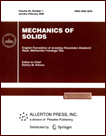 | | Mechanics of Solids
A Journal of Russian Academy of Sciences | | Founded
in January 1966
Issued 6 times a year
Print ISSN 0025-6544
Online ISSN 1934-7936 |
Archive of Issues
| Total articles in the database: | | 13362 |
| In Russian (»Á‚. –ņÕ. Ő““): | | 8178
|
| In English (Mech. Solids): | | 5184 |
|
| << Previous article | Volume 60, Issue 4 / 2025 | Next article >> |
| Lai Dang Giang, Nguyen Van Chinh, Tran Duc Hoan, and To Thanh Loan, "Evaluation of Constitutive Models for AA2024 Aluminum Alloy: Insights from Tensile and Rastegaev Compression Tests," Mech. Solids. 60 (4), 2648-2659 (2025) |
| Year |
2025 |
Volume |
60 |
Number |
4 |
Pages |
2648-2659 |
| DOI |
10.1134/S0025654425601429 |
| Title |
Evaluation of Constitutive Models for AA2024 Aluminum Alloy: Insights from Tensile and Rastegaev Compression Tests |
| Author(s) |
Lai Dang Giang (Le Quy Don Technical University, Hoang Quoc Viet 236, Hanoi, 100000 Vietnam)
Nguyen Van Chinh (Le Quy Don Technical University, Hoang Quoc Viet 236, Hanoi, 100000 Vietnam)
Tran Duc Hoan (Le Quy Don Technical University, Hoang Quoc Viet 236, Hanoi, 100000 Vietnam, tranduchoan@lqdtu.edu.vn)
To Thanh Loan (School of Materials Science and Engineering, Hanoi University of Science and Technology, Dai Co Viet 1, Hanoi, 100000 Vietnam) |
| Abstract |
This study presents a comprehensive evaluation of four widely used constitutive modelsĖHollomon, Ludwik, Swift, and VoceĖin predicting the flow behavior of AA2024 aluminum alloy under both tensile and compressive loading conditions. True stressĖstrain curves were constructed from experimental tensile test data and extended to high-strain conditions (true strain up to 3.0) to assess their predictive accuracy through numerical simulations of the Rastegaev compression test. At small strains, the Ludwik model demonstrated the highest accuracy (R2=0.99414), followed by the Swift model, while the Voce and Hollomon models showed relatively lower accuracy. However, in the large-strain regime, the Voce model exhibited superior predictive performance, particularly due to its ability to represent stress saturation, with the lowest simulation error in the Rastegaev test. These findings highlight the importance of selecting appropriate constitutive models based on strain regime and loading type. The results provide valuable insights for improving the reliability of finite element simulations in bulk forming processes involving lightweight aluminum alloys. The validated models can support the optimization of industrial forming operations and enhance material behavior prediction in large-deformation conditions. |
| Keywords |
AA2024-O, constitutive modeling, flow stress, tensile test, compression test, large strain, numerical simulation |
| Received |
26 March 2025 | Revised |
07 May 2025 | Accepted |
09 May 2025 |
| Link to Fulltext |
|
| << Previous article | Volume 60, Issue 4 / 2025 | Next article >> |
|
 If you find a misprint on a webpage, please help us correct it promptly - just highlight and press Ctrl+Enter If you find a misprint on a webpage, please help us correct it promptly - just highlight and press Ctrl+Enter
|
|

 Russian
Russian  English
English